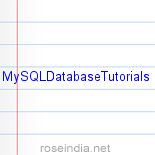MySQL Database Tutorials
- SQL
Tutorial
The Structured Query Language is used in manipulating data stored in Relational Database Management Systems (RDBMS). SQL provides commands through which data can be extracted, sorted, updated, deleted and inserted. SQL has the full support of ANSI (American National Standards Institute), which has laid down certain rules for the language. SQL can be used with any RDBMS such
as MySQL, mSQL, PostgresSQL, Oracle, Microsoft SQL Server, Access, Sybase, Ingres etc. All the important and common SQL statements are supported by these RDBMS, however, each has its own set of proprietary statements and extensions.
- MySQL
Information
MySQL is a database. A database is a data storage feature. It can be used to store, sort, arrange, and display information. MySQL is a functional feature on it's own. For our tutorials, we will be using PHP commands to use the functions of a MySQL database. phpMy
Admin is a graphical interface program that allows you to use the functions of a MySQL database. Some hosts may have this program available. MySQL is a data storage area. In this storage area, there are small sections called TABLES. Very similar to a normal HTML table, the MySQL tables consist of rows, columns, and cells.
- MySQL Reference Manual w/ Tutorial Intro
The MySQL® software delivers a very fast, multi-threaded, multi-user, and robust SQL (Structured Query Language) database server. MySQL Server is intended for mission-critical, heavy-load production systems as well as for embedding into mass-deployed software. MySQL is a registered trademark of MySQL AB. The MySQL software is Dual Licensed. Users can choose to use the MySQL software as an Open Source product under the terms of the GNU General Public License (http://www.fsf.org/licenses/) or can purchase a standard commercial license from MySQL AB. See http://www.mysql.com/company/legal/licensing/ for more information on our licensing policies.
- Mysql++A C++ API for Mysql
MySQL++ is a C++ wrapper for MySQL's C API. It is built around STL principles, to make dealing with the database as easy as dealing with an STL container. MySQL++ relieves the programmer of dealing with cumbersome C data structures, generation of repetitive SQL statements, and manual creation of C++ data structures to mirror the database schema.If you have any questions about this project, do not email me about it. Search for solutions on the MySQL++ mailing list first, and post to that list if you can't find the answer you need. I monitor that mailing list. By posting to the mailing list, your question and any answers are archived for future developers to find, and you may get better answers than if you just ask me.
- MySQL Basics--A Tutorial
This MySQL tutorial is a guide for new MySQL users, providing a reference of very basic, step by step, instructions on how to get started. This MySQL help page also gives more advanced users assistance in upgrading and running multiple versions of MySQL on a computer at the same time.MySQL is an SQL based relational database management system (DBMS) that runs under a broad array of operating systems. MySQL is frequently used by PHP and Perl scripts. The SQL commands discussed in this tutorial apply to MySQL operating under all operating systems. Only the installation instructions are Windows specific. The focus is on Windows XP Professional and Windows 2000 Professional machines.
- Setting Up a MySQL Based Website-Part I
In this age of the full-service internet, the demand for bigger and badder websites will only increase. To meet the demands of these full-service websites, the SQL database servers come into play. One of the more popular SQL servers available for download on the internet is MySQL. MySQL is not released under a full GPL free license, but for some applications, like intranets, it is free to use. For most users, a $200 license will have to be purchased. However, this price compares very favourably with other companies producing database backends for the commercial market, like IBM, Oracle and Sybase.
- MySQL on Mac OS X
MySQL has become one of the most popular databases for Web applications. The database is well suited for common Web-related tasks like content management, and for implementing Web features like discussion boards and guestbooks. For a time, some developers avoided MySQL for commercial applications because it did not implement certain features, such as transactions. But this is no longer the case, and MySQL is a great choice for just about any Web-based application.In this article I?ll give you an overview of MySQL?s features and drawbacks, show you how to install MySQL on Mac OS X, and introduce you to some of MySQL?s notable technical aspects.
